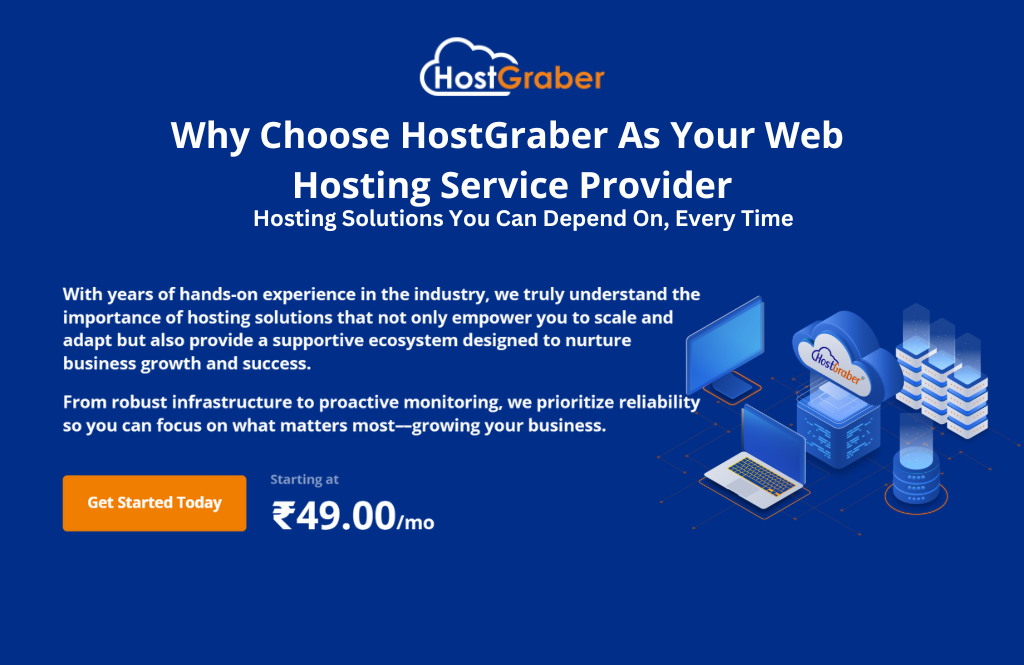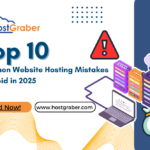Dreaming of escaping the 9-to-5 grind and building a business you can run from anywhere with an internet connection? Starting an online business is more accessible than ever before, but what it requires is careful planning and execution. With the right tools and strategies, anyone can build a profitable online venture. Whether you’re looking to turn your hobby into a source of income or launch a full-fledged e-commerce store, this step-by-step guide will help you launch a profitable online venture from scratch, covering everything from in-depth market research to advanced marketing strategies. And if you’re wondering how to ensure a smooth start, HostGraber’s beginner-friendly web hosting plans can give you the reliable foundation you need.
Step 1: Conduct Market Research – Validates Your Idea
Before investing time and resources, the first step to starting a profitable online business is understanding the market. Market research helps you identify what your target audience needs and ensures there’s demand for your products or services.
How to Conduct Market Research:
1. Identify Your Niche- Finding Your Sweet Spot:
Think about what you’re passionate about or areas where you have expertise. Popular niches include health, fashion, technology, and personal development. Don’t try to compete in broad, saturated markets. Instead, identify a specific niche with unmet needs. The more specific you are, the easier it will be to target your marketing efforts. Consider these factors:
- Passion: Choose a niche you’re genuinely interested in. This will keep you motivated during challenging times.
- Profitability: Research the potential profitability of your chosen niche. Are people willing to spend money on products or services in this area?
- Competition: Analyze the competitive landscape. Are there many established players? If so, how can you differentiate yourself?
2. Analyze the Competition- Know Your Opponents:
Look at competitors in your niche. Study their websites, product offerings, and marketing strategies. Tools like SEMrush and Google Trends can help you understand trends and demand. Look at their:
- Products/Services: What are they offering? What are their strengths and weaknesses?
- Pricing: How are they pricing their products/services?
- Marketing Strategies: How are they reaching their target audience?
- Online Presence: Analyze their website, social media presence, and online reviews.
3. Understand Your Audience- Find Your Ideal Customer:
Create detailed buyer personas to represent your ideal customers. Consider their:
- Demographics: Age, gender, location, income, education.
- Psychographics: Interests, values, lifestyle, attitudes.
- Needs and Pain Points: What problems are they trying to solve?
- Online Behavior: Where do they spend their time online? What social media platforms do they use.
4. Validate Your Idea:
Use platforms like surveys, forums, and social media to gather feedback from potential customers. Ask if they would buy your product or service and at what price.
5. Keyword Research – Find What People Search For:
Use keyword research tools like Google Keyword Planner, Ahrefs, SEMrush, and Moz Keyword Explorer to identify relevant keywords and search terms related to your niche. This will inform your content strategy and SEO efforts.
Case Study: Imagine you’re exploring a niche in handmade candles. By joining online groups focused on home decor, you discover a demand for soy-based candles with unique fragrances. This insight can help you tailor your offerings to meet specific customer needs.
Step 2: Choosing the Right Online Business Model – Aligning with Your Goals
Once you’ve identified your niche, decide on a business model that aligns with your goals. Your business model will determine how you make money. Here’s a more in-depth look at some popular options:
Popular Online Business Models:
1. E-commerce – Building Your Online Store:
This involves selling physical or digital products directly to consumers through your website. Consider:
- Product Sourcing: Will you create your own products, source them from manufacturers, or use dropshipping?
- Inventory Management: How will you manage your inventory?
- Shipping and Fulfillment: How will you handle shipping and fulfillment?
- Platform Choice: Will you build your own online store using platforms like Shopify or WooCommerce, or sell through marketplaces like Amazon or Etsy?
2. Dropshipping – Selling Without Inventory:
This model allows you to sell products without holding any inventory. When a customer places an order, you forward it to a third-party supplier who ships the product directly to the customer.
3. Affiliate Marketing – Partnering for Profit:
This involves promoting other companies’ products or services and earning a commission on each sale made through your unique referral link.
4. Blogging/Content Creation – Building an Audience:
Creating valuable content attracts an audience you can monetize through various methods.
5. Online Courses/Consulting – Sharing Your Expertise:
Package your knowledge and expertise into online courses or offer one-on-one consulting services remotely.
6. Freelancing – Selling Your Skills:
Offer your skills on a project basis to various clients such as writing, graphic design, or web development.
Pros and Cons of Each Model:
- E-commerce: High control but requires inventory management.
- Dropshipping: Low upfront costs but lower profit margins.
- Affiliate Marketing: Passive income but depends on traffic volume.
- Blogging/Content Creation: Minimal investment and freedom of creativity but requires consistent time and effort to grow.
- Courses/Coaching: High-profit margins but requires expertise.
- Freelancing: Flexible but time-intensive.
Choose a model that aligns with your skills, interests, and investment capacity.
Step 3: Building a Powerful Online Presence
Your online presence is your digital storefront. It’s where customers interact, discover and engage with your business or brand.
Steps to Build Your Online Presence:
1. Domain Name Selection –
Your Online Address: Choose a domain name that reflects your brand and is relevant, memorable, and easy to spell. Consider using relevant keywords if possible.
2. Web Hosting –
The Foundation of Your Online Business: Reliable and supportive hosting is non-negotiable. Use a reliable web hosting service like HostGraber, GoDaddy, Hostinger to ensure your site is always online and loads quickly.
Here’s why HostGraber is a great choice:
- Enhanced Uptime and Reliability: HostGraber’s robust infrastructure with its data center located in Eastern India ensures maximum uptime, minimizing the risk of your website going offline.
- Optimized Performance and Speed: Fast loading times are crucial for user experience and SEO. HostGraber’s servers are optimized for speed and performance with full root access and 1Gbps network speed.
- Advanced Security Measures: HostGraber offers comprehensive security features like Imunify360 Protection, DDoS Protection to protect your website from threats.
- Scalability for Growth: As your business expands, HostGraber’s scalable hosting solutions can accommodate your increasing needs.
- Dedicated Customer Support: HostGraber provides 24/7 customer support to assist you with any issues.
- Beginner-Friendly Features: HostGraber provides easy-to-use control panels, one-click installations, and other features that make it easy for beginners to get started.
3. Design Your Website– Create a Positive First Impression:
- Your website should be visually appealing, easy to navigate, and mobile-friendly.
- Pick a beginner-friendly website builder or CMS like WordPress, Shopify, or Wix.
- Highlight your products, services, or value proposition on the homepage.
- Include important website pages like About Us, Contact Us, FAQs, and Privacy Policy.
4. Set Up Social Media Accounts:
- Choose platforms where your target audience is active (e.g., Instagram, LinkedIn, Facebook).
- Use consistent branding across all profiles.
- Post valuable and engaging content regularly.
5. List Your Business on Online Directories:
Register on platforms like Google My Business, Yelp, or industry-specific directories to increase visibility.
Step 4: Develop a Marketing Strategy- Reach Your Target Audience
A great product or service is useless if no one knows about it. A detailed marketing strategy is essential for attracting customers and sales. With the right strategies, you can reach your target audience effectively.
Online Marketing Strategies:
1. Search Engine Optimization (SEO) – Getting Found on Google:
SEO is the process of optimizing your website and content to rank higher in search engine results pages (SERPs). This involves:
- Keyword Research: Optimize your website content for relevant keywords that your target audience is searching for.
- On-Page Optimization: Optimizing your website’s content, meta tags, and structure for relevant keywords.
- Off-Page Optimization: Building high-quality backlinks from other reputable websites.
- Technical SEO: Ensuring your website is technically sound and easy for search engines to crawl and index.
- Write blog posts, product descriptions, and meta tags to rank higher on search engines.
2. Content Marketing – Providing Value and Building Trust:
Content marketing focuses on creating and distributing valuable, relevant, and consistent content to attract and retain a clearly defined audience — and, ultimately, to drive profitable customer action.
- Blog Posts: Publish informative and engaging blog posts to share useful information and position yourself as an expert in your niche.
- Videos: Create video content for platforms like YouTube and Vimeo.
- Infographics: Create visually appealing infographics to present data and information in an engaging way.
- Podcasts: Create audio content that your audience can listen to on the go.
3. Social Media Marketing – Engaging Your Audience:
Social media is a powerful tool for building brand awareness, connecting with your target audience, and driving traffic to your website.
- Platform Selection: Choose the social media platforms that your target audience uses most.
- Content Strategy: Create engaging and valuable content that resonates with your audience.
- Community Building: Engage with your followers and build a strong online community.
- Social Media Advertising: Use paid advertising to reach a wider audience and target specific demographics. Run targeted ads on platforms like Facebook, Instagram, or Google. Use retargeting ads to re-engage users who visited your website but didn’t make a purchase.
4. Paid Advertising (PPC) – Driving Targeted Traffic:
Pay-per-click (PPC) advertising allows you to drive targeted traffic to your website by paying for each click on your ads.
- Google Ads: Run search and display ads on Google to reach potential customers who are actively searching for products or services like yours.
- Social Media Ads: Run targeted ads on social media platforms like Facebook, Instagram, and LinkedIn. Use retargeting ads to re-engage users who visited your website but didn’t make a purchase.
5. Email Marketing – Building Relationships and Driving Sales:
Email marketing is a highly effective way to nurture leads, build customer relationships, and promote your products or services.
- Building an Email List: Build an email list using sign-up forms on your website. Offer valuable incentives, such as free ebooks or discounts, to encourage visitors to subscribe to your email list.
- Offers and Promotions: Send newsletters, product updates, and promotions to your subscribers.
- Segmenting Your Audience: Segment your email list based on demographics, interests, or purchase history to send targeted emails.
- Creating Engaging Emails: Craft compelling email content that provides value to your subscribers.
- Automating Your Email Campaigns: Use email marketing automation tools to send automated emails based on user behavior.
6. Influencer Marketing:
- Partner with influencers in your niche to promote your products or services.
- Micro-influencers with smaller but highly engaged audiences are often cost-effective.
Step 5: Launch Your Business
Once your website and marketing strategies are in place, it’s time to launch your business. A successful launch creates excitement and attracts customers.
Tips for a Successful Launch:
1. Announce on Social Media:
- Share teasers leading up to the launch.
- Host a live event or giveaway to generate buzz.
2. Leverage Your Network:
- Ask friends, family, and colleagues to spread the word.
- Reach out to your email list and inform them about the launch.
3. Offer Discounts or Promotions:
- Create limited-time offers to encourage first-time purchases.
- Provide free shipping or bonuses for early adopters.
4. Collect Feedback:
- Use surveys and customer reviews to identify areas for improvement.
- Continuously refine your products, services, or website based on feedback.
Step 6: Monitor and Scale Your Business– Continuous Improvement
Once your business is up and running, focus on monitoring performance and scaling your operations. Launching an online business is not a one-time event. It’s an ongoing process of learning, adapting, and improving.
Key Metrics to Monitor:
1. Website Traffic:
Use tools like Google Analytics to track the number of visitors to your website traffic, bounce rate, conversion rate, and customer behavior.
2. Conversion Rate:
Measure the percentage of visitors who make a purchase or sign up.
3. Customer Acquisition Cost (CAC):
Calculate how much you spend to acquire a new customer.
4. Customer Retention Rate:
Focus on retaining existing customers through loyalty programs or personalized offers.
5. Data Analysis:
Analyze your data to identify trends, understand what’s working and what’s not, and make data-driven decisions.
6. A/B Testing (Optimizing Your Website and Marketing Campaigns):
Conduct A/B tests to compare different versions of your website and marketing campaigns to identify which ones perform best.
7. Customer Feedback:
Collect customer feedback through surveys, reviews, and social media to understand their needs and improve your products or services.
8. Staying Updated with the Latest Trends:
The online world is constantly evolving. Stay updated on the latest trends, technologies, and marketing strategies to stay ahead of the competition.
9. Scaling Your Business:
Once you’ve established a successful online business, you can start thinking about scaling your operations. This could involve expanding your product line, targeting new markets, or hiring additional staff.
Strategies to Scale:
- Expand Product Lines: Introduce new products or services based on customer feedback.
- Automate Processes: Use tools to automate email marketing, social media posting, or inventory management.
- Invest in Paid Ads: Allocate a portion of your profits to increase ad spending.
- Go Global: Target international markets by offering multi-language support or international shipping.
Conclusion:
Starting a profitable online business from scratch is challenging but with the right approach and tools, it’s entirely achievable. It requires careful planning, dedication, and a willingness to adapt and learn. By following the steps outlined in this guide and leveraging the right tools and resources, including reliable web hosting from providers like HostGraber, you can significantly increase your chances of success.
Remember that building a successful business takes time and effort. Be patient, persistent, and always focus on providing value to your customers. With the right mindset and a solid strategy, you can turn your online business aspirations into a thriving reality.
So, what are you waiting for? Take the first step today, and let HostGraber be your partner in building a thriving online business!




